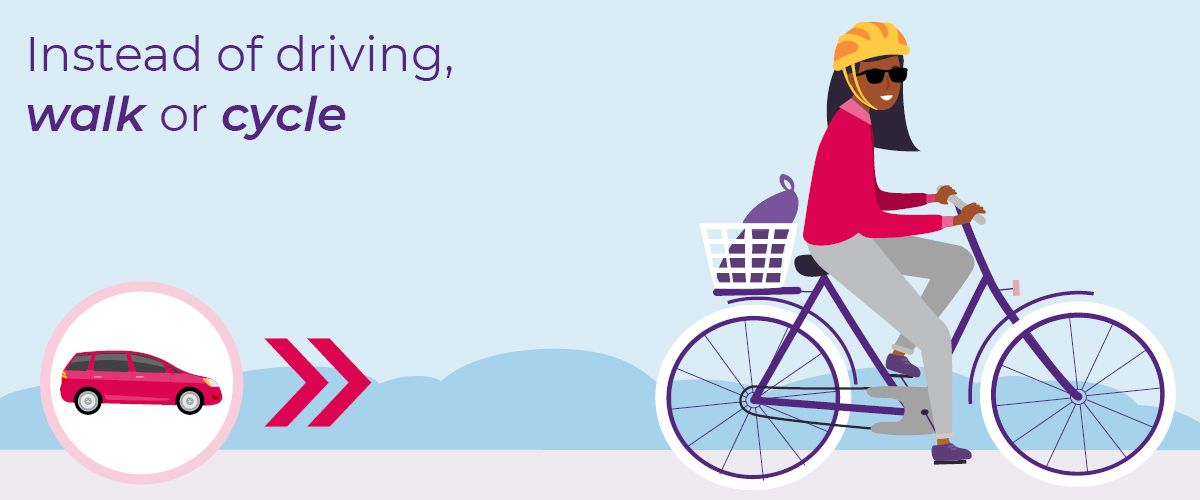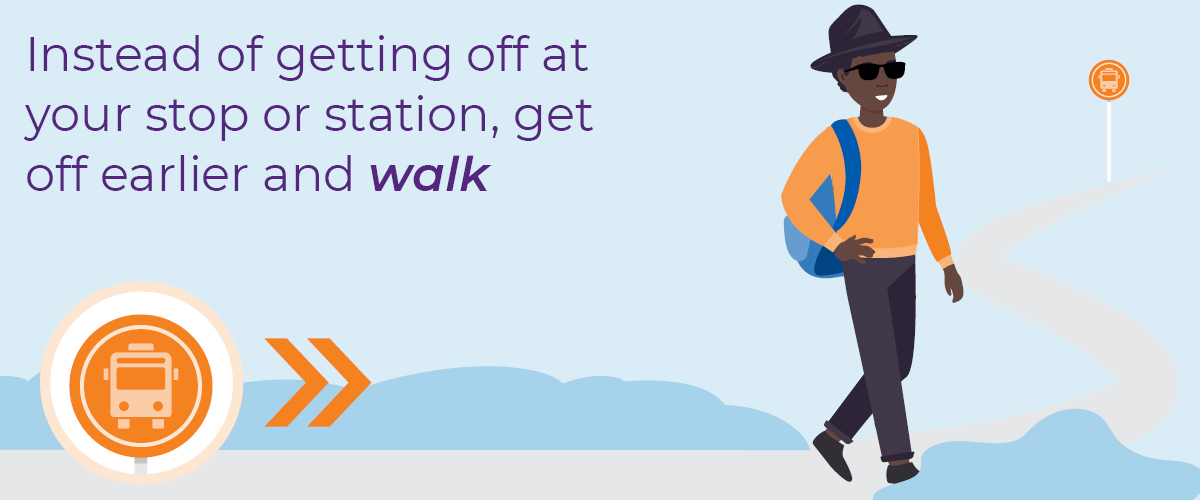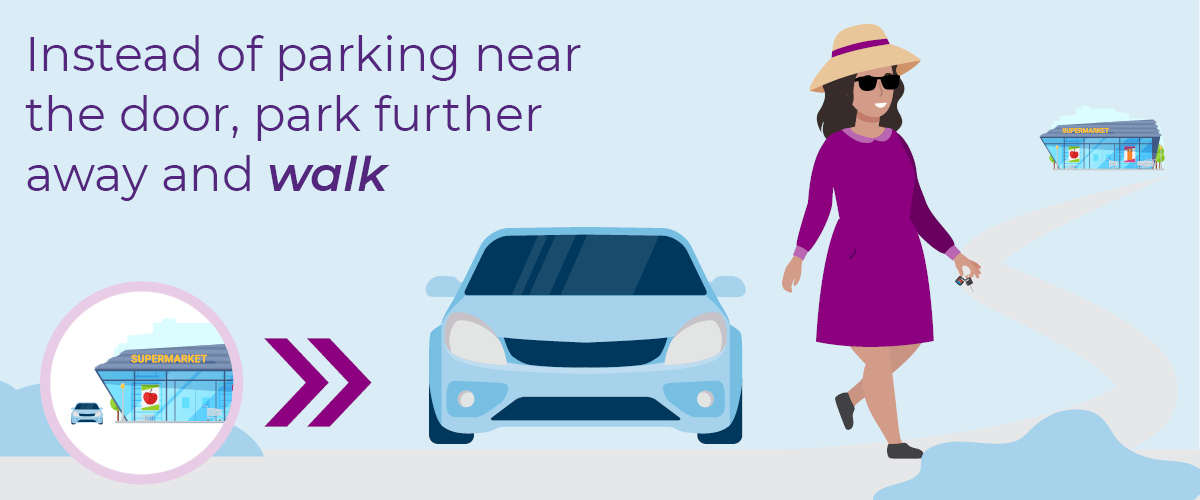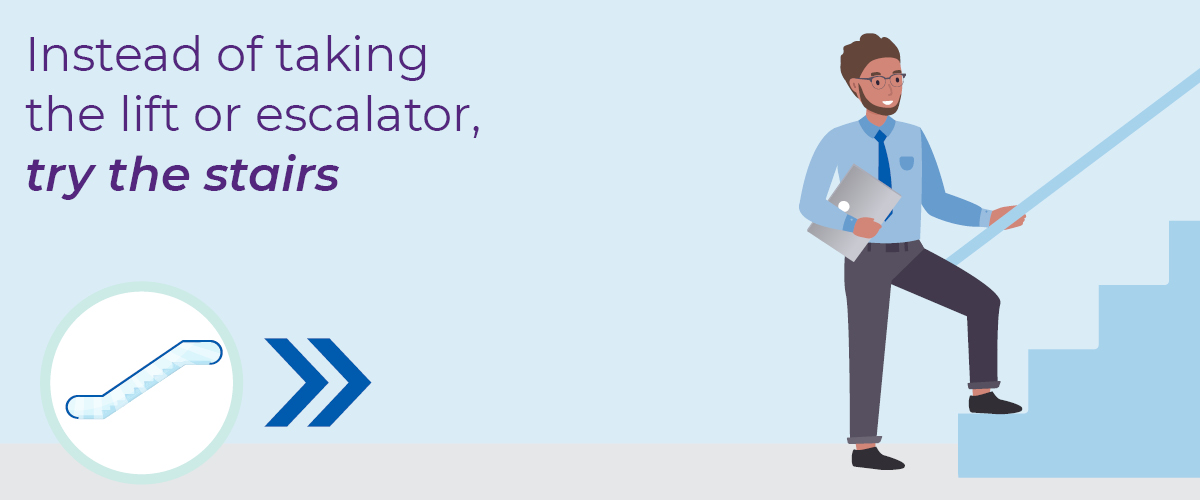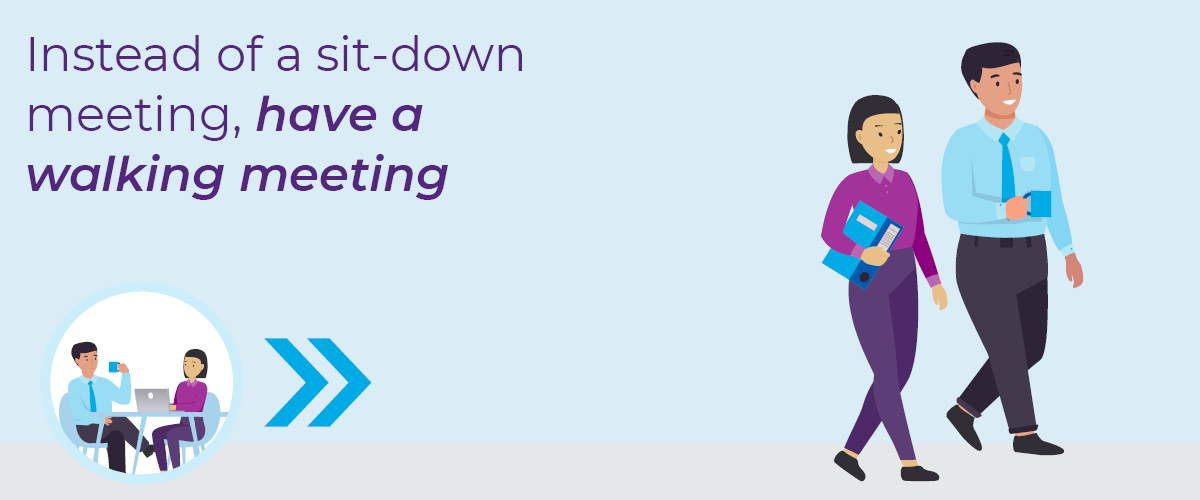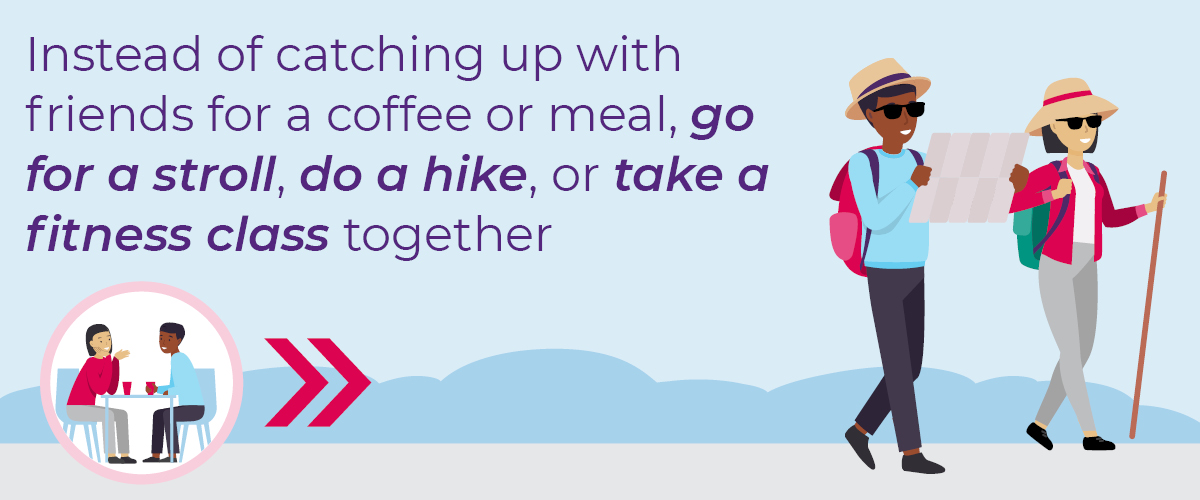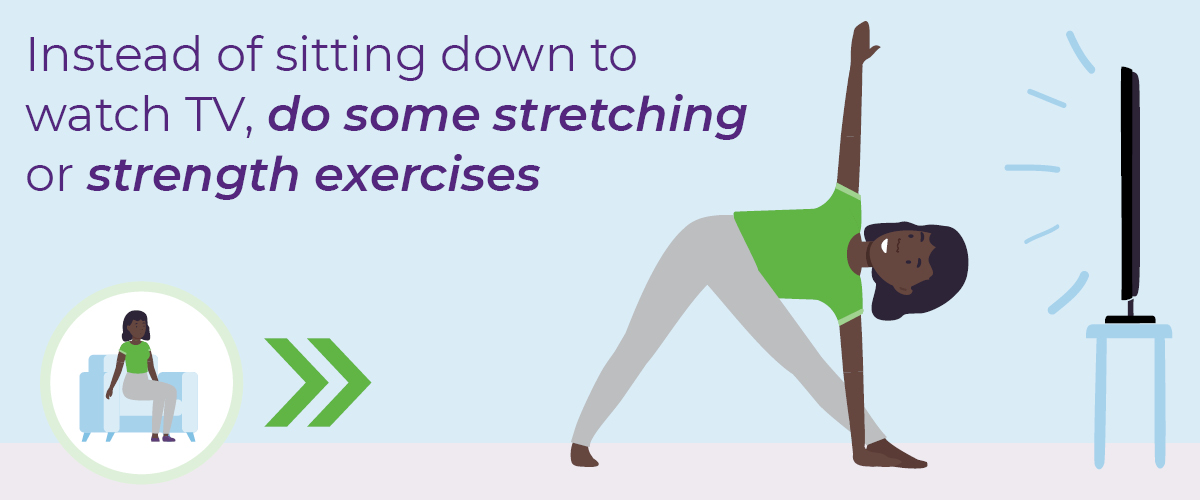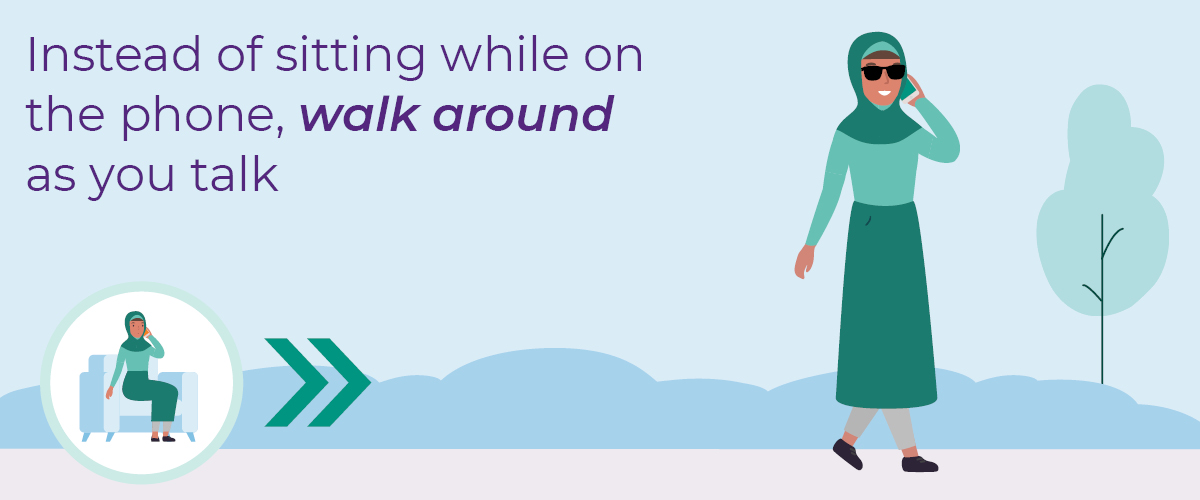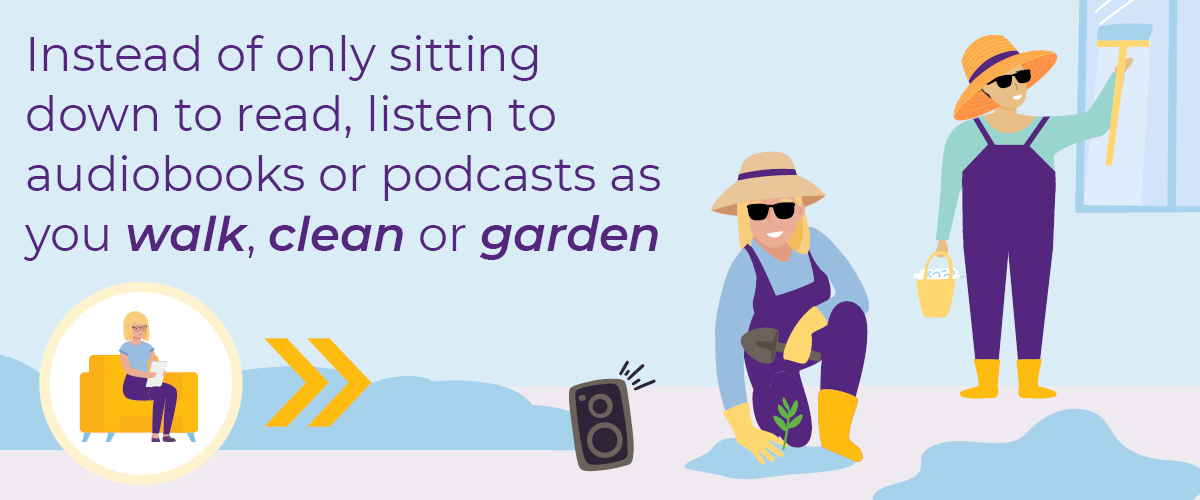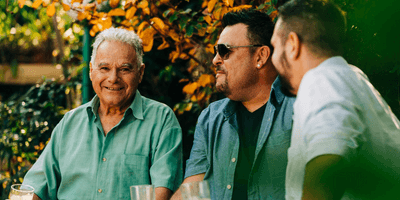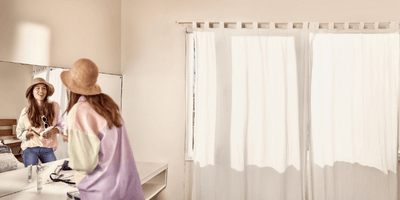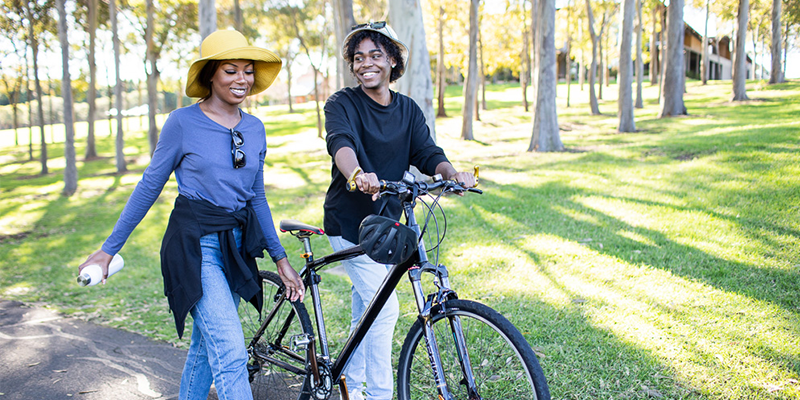Be more active
Sitting less and moving more cuts your risk of cancer.[1] Being physically active reduces the risk of 13 types of cancer.[6] There is evidence that exercise may even help stop some cancers, like breast cancer,[2] from returning.
Physical inactivity is one of the top four biggest causes of Australia's cancer burden.[3]
The Cancer Institute recommends one hour of moderate activity or 30 minutes of vigorous activity every day to help reduce your cancer risk and live a healthier life. Regardless of how old you are, the more you move, the better. Moderate activity noticeably raises your heart rate. Vigorous exercise makes your heart beat even faster and puff or breath rapidly.[4]
It is not always easy to fit the recommended amount of exercise into your day. Remember: it is okay to start small and build up to more activity.
Get the facts
More than half of all Australian adults are not active enough [4]
Exercise reduces your risk of colon, endometrial and breast cancer [7]
Physical inactivity is responsible for 16% of the bowel cancer burden [5]
How does regular exercise prevent cancer?
Exercising regularly builds overall health and reduces the risk factors for development of thirteen different cancers.[6] Exercise helps reduce overweight and obesity, which is important for reducing cancer risk. Reducing the time over each day spent without moving, sometimes called sedentary behaviour, also reduces cancer risk.[1]
Research shows that exercise reduces your risk of colon, endometrial, and breast cancer. Research also suggests that exercise may reduce your risk of oesophageal, lung and liver cancer, and that being sedentary (inactive) may increase your risk of endometrial cancer.[7]
Getting more movement in your every day:
- reduces insulin and insulin-like growth factors that can cause cancer cells to grow[8]
- moves waste and cancer-causing toxins out of the body faster[8]
- strengthens the immune system to help prevent cancer cells from growing[8]
- lowers blood oestrogen levels, important for lowering breast cancer risk[8]
- improves mood and promotes a positive outlook.[9]
Our recommendation
Get up to one hour of moderate activity or 30 minutes of vigorous activity each day to reduce your cancer risk. The more you move, the better.
How much exercise is enough?
Even small amounts of exercise are good for you. To maintain your general level of health, start with 30 minutes of moderate intensity exercise each day. Aiming for one hour of moderate intensity exercise or 30 minutes of vigorous intensity exercise every day can help cut your risk of cancer.[10]
You can do it all at once or in short 10-minute bursts throughout the day.
If you can talk while exercising, it is moderate intensity. Exercise that makes you ‘huff and puff’ is vigorous intensity.
Here are some great examples of moderate intensity activity:
- Brisk walking to/from the train or bus stop
- Dancing
- Social tennis
- Recreational swimming
- Climbing stairs
- Gardening
- Cleaning windows
- Mowing the lawn
- Pushing a stroller
- Cycling to/from work
Want some ideas for vigorous intensity activity?
- Jogging
- Aerobics
- Fast cycling
- Boxing
- Competitive or team sports like football or netball
- Lifting and carrying
Muscle strengthening activities, like weights, squats or digging in the garden, have also shown to reduce the risk of early death from cancer. Aim to do these types of exercises on at least two days each week.[11]
What if you exercise a lot but still spend most of your day sitting?
There is a difference between being physically inactive and sedentary behaviour. Sitting for long periods at work or lying on the couch at home are examples of being sedentary. A person can exercise enough to meet the guidelines and also spend too long sitting each day.[11]
How can you build more activity into each day?
Doing some exercise is better than doing none. Start small and build up. Simple swaps can make a big difference.
Where can I find physical activity?
Police and Community Youth Club (PCYC):
- Link: https://www.pcycnsw.org.au/find-a-club
- For who: School age, young adult, adults
- Comment: PCYC aims to empower young people to reach their potential. They also provide exercise classes for all ages and abilities. Search for your local club.
Office of Sport:
- Link: https://www.sport.nsw.gov.au/find-a-sport
- For who: All
- Comment: Not sure which activity to start with? The Office of Sport provides a list of many different sporting organisations in NSW to get involved with. You can also find specific sports and organisations for people with disability.
Sports Australia
- Link: https://www.sportaus.gov.au/australian_sports_directory
- For who: All
- Comment: Want to discover more sports offered around the country? Sports Australia provides a list of recognised national sporting organisations.
Heart Foundation Walking Groups
- Link: https://walking.heartfoundation.org.au/
- For who: All
- Comment: Health Foundation Walking list free walking groups by postcode or suburb. This would be a great way to start moving and meet new people in your neighbourhood. Find a group near you!
Parkrun:
- Link: https://www.parkrun.com.au/
- For who: All
- Comment: Parkruns are free weekly community 5km-runs which provide a positive, welcoming, and inclusive experience. You can run, jog, walk, volunteer or spectate.
Pride in Sports:
- Link: https://www.prideinsport.com.au/lgbtq-sports-club-directory/
- For who: LGBTQ persons seeking socially inclusive clubs
- Comment: Pride in Sports is a national group which assists sporting organisations with the inclusion of diverse genders and sexualities. Find a supportive sporting club here.
Get Healthy:
- Link: https://www.gethealthynsw.com.au/program/
- For who: All
- Comment: Get Healthy is a personalised phone-based health coaching service that supports adults in making healthy lifestyle changes. Doctors and health professionals can provide referrals to this free service. There are dedicated pregnancy, diabetes, alcohol reduction, Aboriginal and Chinese coaching programs.
Active and Healthy
- Link: https://www.activeandhealthy.nsw.gov.au/
- For who: Older adults
- Comment: Active and Healthy provides information and tools for older adults and exercise professionals to increase their physical activity. Look for exercise and falls prevention classes in your area.
NSW Knockout Health Challenge
- Link: https://www.nswknockouthealthchallenge.com.au/frontpage/
- For who: Ages 16+
- Comment: Get your mob together and take part in a free program that encourages healthy eating and a more active lifestyle. This group challenge provides start up support and generous prizes for overall winners.
Local Council:
- Link: https://www.olg.nsw.gov.au/public/find-my-council/
- For who: People seeking local culturally and linguistically relevant groups
- Comment: Your local council may have information about community groups and local facilities to support your physical activity.
CanRevive:
- Link: https://www.canrevive.com/
- For who: Chinese speaking community
- Comment: CanRevive provides support for Chinese language speaker, and organise opportunities for exercise classes.
Mums Exercise Group Australia (MEGA)
- Link: https://www.megamums.com.au/branches
- For who: Catered for all mothers
- Comment: MEGA empowers mothers to improve their social, emotional and physical wellbeing. There are multiple free and low-cost community fitness sessions on offer around NSW.
Get Healthy at Work
- Link: https://www.gethealthyatwork.com.au/
- For who: Workplace managers
- Comment: A free program for all businesses in NSW that helps to build health workplaces and improves health and wellbeing of workers.
Fitness Passport
- Link: https://www.fitnesspassport.com.au/members-families/
- For who: Organisations and their employees
- Comment: Fitness Passport provides employees of registered organisations with a discounted access to various fitness facilities.
More information and resources
- Download and print our Be more active reduce your cancer risk factsheet (PDF).
- Download and print our worksheet on tips to help you get started with physical activity (PDF).
- Find ways to get moving at Healthy Eating Active Living, a NSW Government website.
- Get Healthy NSW can help you get active. Use the free coaching service to set goals and stay motivated.
- The Australian Government’s Physical activity and sedentary behaviour guidelines explains how much exercise you need at every life stage. They have tips on getting started, and lots of practical ideas for sitting less and moving more.
- Use the Get Healthy NSW activity planner (PDF) to plan and track what you do to keep active.
- The Staying well and preventing cancer flipchart was developed for community educators supporting multicultural communities. It starts the conversation around cancer prevention and healthy living behaviours including healthy eating, being active, being a healthy body weight, not smoking, protecting your skin and participating in cancer screening.
1. World Cancer Research Fund International/American Institute for Cancer Research. Food, nutrition, physical activity, and the prevention of cancer: A global perspective. Washington DC: AICR, 2008. Available from: http://www.wcrf.org/sites/default/files/Second-Expert-Report.pdf
2. Eliassen, A. H., Hankinson, S. E., Rosner, B., Holmes, M. D., & Willett, W. C. (2010). Physical activity and risk of breast cancer among postmenopausal women. Archives of internal medicine, 170(19), 1758–1764. Available from: https://doi.org/10.1001/archinternmed.2010.363
3. Australian Institute of Health and Welfare 2017. Burden of Cancer in Australia: Australian Burden of Disease Study 2011. Australian Burden of Disease Study series no. 12. Cat. no. BOD 13. Canberra: AIHW.
4. More than half of all Australian adults are not active enough. Source: Australian Bureau of Statistics (ABS) 2013. Australian Health Survey: Physical Activity, 2011-12. ABS Cat. No. 4364.0.55.004. Canberra: ABS.
5. Australian Institute of Health and Welfare 2017. Impact of physical inactivity as a risk factor for chronic conditions: Australian Burden of Disease Study. Australian Burden of Disease Study series no. 15 Cat. no. BOD 16. Canberra: AIHW Available from: https://www.aihw.gov.au/reports/burden-of-disease/impact-of-physical-inactivity-chronic-conditions/contents/table-of-contents (Accessed 7 September 2020)
6. Estimating cancers attributable to physical activity in Australia, Louisa Ellis, Roger Milne, Melissa Moore, Kieron Bigby, Craig Sinclair, Darren Brenner, Steven C.Moore, Charles E Matthews, Julie K. Bassett and Brigid Lynch. Journal of Science and Medicine in Sport; Volume 27, Issue 3, p 149-153,. March 2024 Available from: https://www.jsams.org/article/S1440-2440(23)00514-5/fulltext
7. World Cancer Research Fund/American Institute for Cancer Research. Continuous Update Project Expert Report 2018. Physical activity and the risk of cancer. Available at dietandcancerreport.org Accessed: 8 September 2020\
8. World Cancer Research Fund/American Institute for Cancer Research. Continuous Update Project Expert Report 2018. Physical activity and the risk of cancer. Available from: dietandcancerreport.org
9. Fox K. Physical activity and mental health promotion: the natural partnership. Journal of Public Mental Health. 2000 Jan 1;2(1):4-12.
10. Australian Government, Australia’s Physical Activity and Sedentary Behaviour Guidelines Available from: https://www1.health.gov.au/internet/main/publishing.nsf/Content/health-pubhlth-strateg-phys-act-guidelines#npa1864 (Accessed Sept 9 2020)
11. Emmanuel Stamatakis, I -Min Lee, Jason Bennie, Jonathan Freeston, Mark Hamer, Gary O’Donovan, Ding Ding, Adrian Bauman, Yorgi Mavros, Does Strength-Promoting Exercise Confer Unique Health Benefits? A Pooled Analysis of Data on 11 Population Cohorts With All-Cause, Cancer, and Cardiovascular Mortality Endpoints, American Journal of Epidemiology, Volume 187, Issue 5, May 2018, Pages 1102–1112, Available from: https://doi.org/10.1093/aje/kwx345
